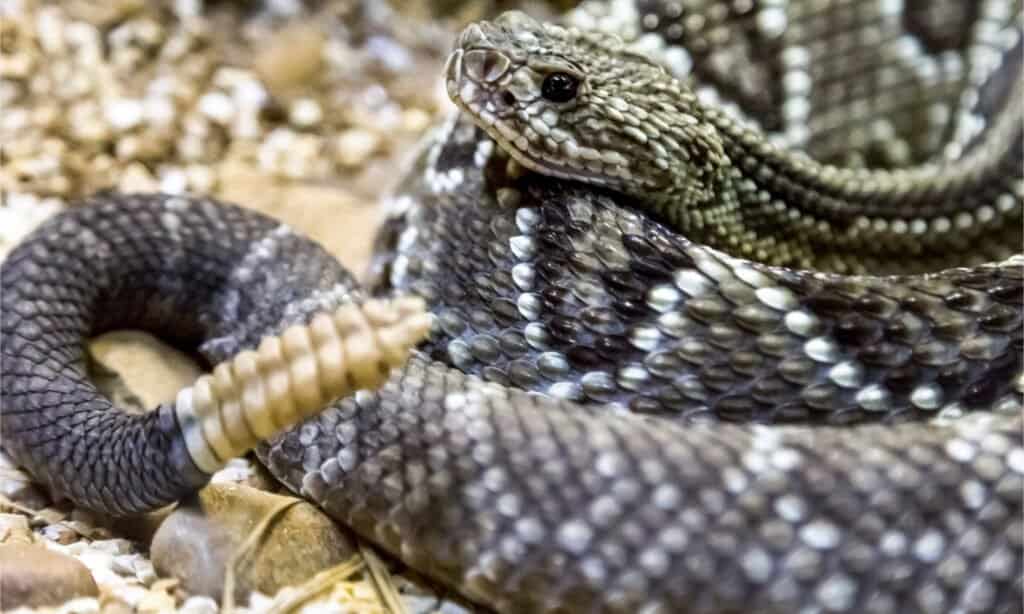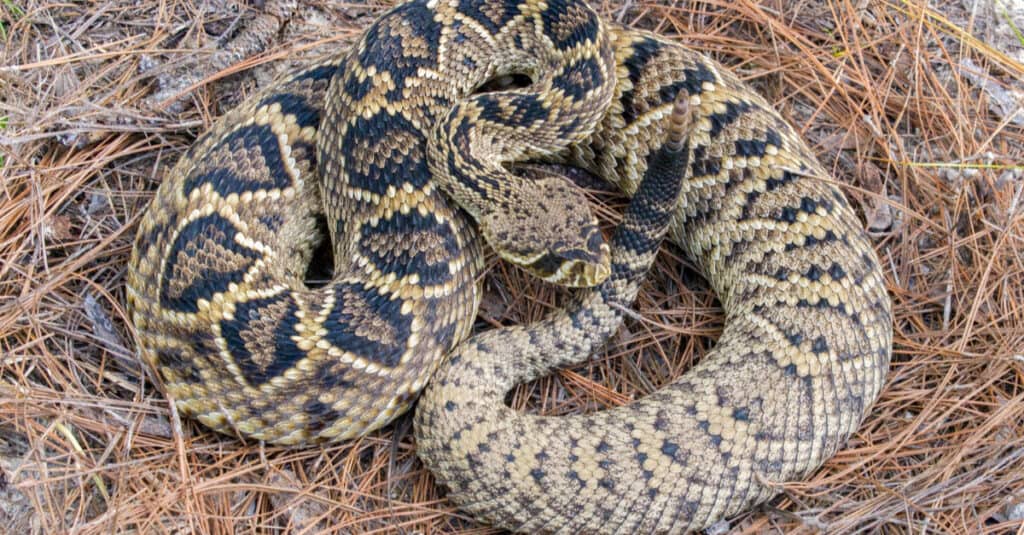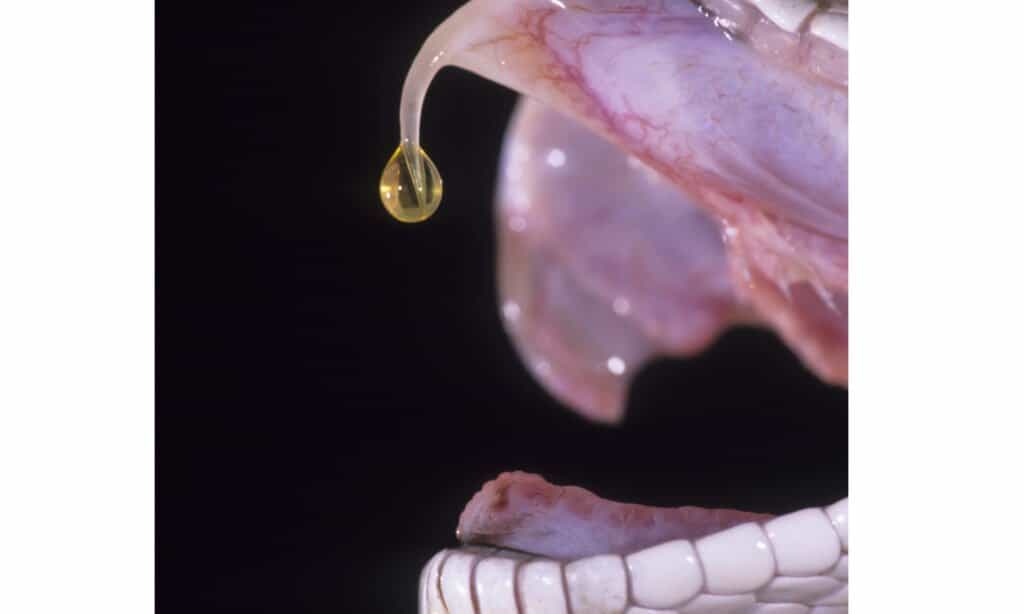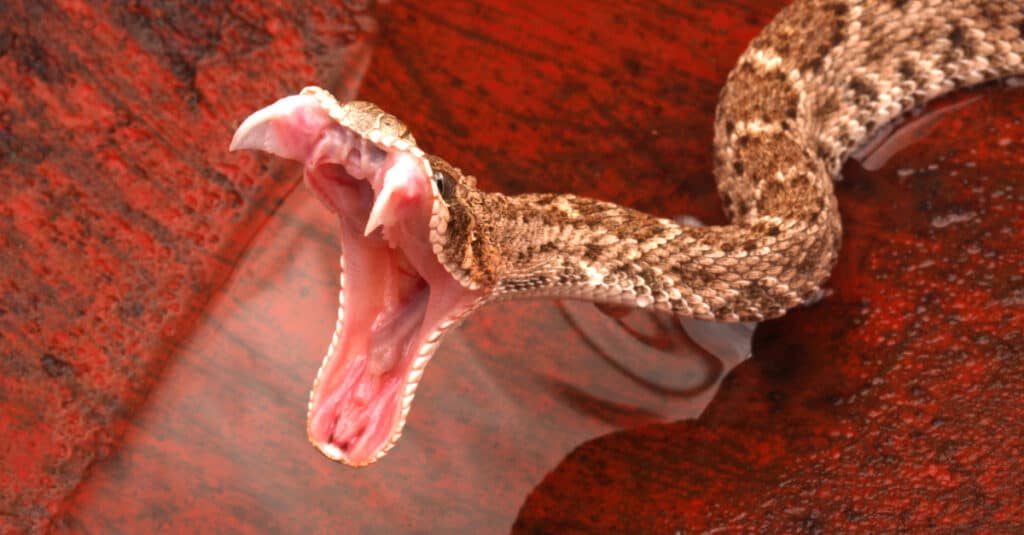Rattlesnakes are among the deadliest venomous snakes in the Americas. These reptiles are iconic for the namesake rattles that they use to scare potential predators. Although everyone knows that these snakes are dangerous, we’re going to take a closer look and reveal 10 incredible rattlesnake facts. Be prepared to see an entirely new side to these deadly predators!
The Top 10 Incredible Rattlesnake Facts

Rattlesnakes are large and dangerous snakes that live in the U.S.
©Alexandree/Shutterstock.com
The most common rattlesnake facts are that the snake is venomous, and it has a rattle. We’ve found ten deeply interesting statistics and data that will help you come to know and rightfully fear these animals. See what you can learn about these snakes!
10. Rattlesnakes Are the Largest Venomous Snake in America

Eastern diamondback rattlesnakes are the biggest venomous snake in the United States.
©Chase D’animulls/Shutterstock.com
The eastern diamondback rattlesnake dis the largest venomous snake in America. The biggest one of these snakes ever seen in the U.S. supposedly measured 94 inches and weighed 34lbs. However, that record was never properly verified, so it’s hard to say that the snake was the largest of the species.
However, a rattlesnake housed in the Central Florida Zoo measured 88 inches in length. That is the longest confirmed rattlesnake and a good sign of just how large they can get!
9. A Life-Saving Rattlesnake Fact: They Can Bite After They’re Dead
Rattlesnakes can deliver a fatal bite to human beings up to an hour after they are “dead.” These snakes have a very slow metabolism, so many of their bodily functions remain active even after they have been fatally wounded.
Several cases have emerged where rattlesnakes have bitten and envenomated someone after they believed the snake was dead. Your best bet is to safely kill, decapitate, and then bury the snake without getting close to it. Otherwise, it can bite you or a pet. An even better plan is to stay away from the snake entirely.
8. Rattlesnake Antivenom Can Cost $20,000 Per Vial

Recovering from a snakebite can cost you thousands of dollars.
©Joe McDonald/Shutterstock.com
If you get bitten by a rattlesnake, you are going to pay the price for recovery. A single vial of antivenom can cost about $20,000, and you will need several vials to recover from this severe injury. One individual in Florida was billed over $1.6 million after needing over 70 vials for a severe bite.
Other cases of people being charged over $100,000 to recover from a rattlesnake bite are somewhat common. Unfortunately, not all of those costs are covered by the hospital or insurance.
7. A Rattlesnake’s Rattle Grows Every Time it Sheds
The rattles on a rattlesnake are made of keratin. Every time the rattlesnake sheds, it grows another section of its rattle. The longer the rattle you see on a rattlesnake, the longer it’s been alive! However, rattles are brittle and often break off, so you can’t count the rattles as an accurate method of telling the age of the snake.
Although some sensationalists have said rattlesnakes are evolving to be quieter and deadlier with no rattles, no solid evidence of that has been seen.
6. The Muscles Controlling a Rattlesnake’s Rattle Activates 50 Times Per Second
The rattlesnake’s rattle is very interesting. When used as part of its threat display, the rattle on the end of the rattlesnake’s tail can shake between 50 and 100 times per second. That is some serious work on the part of the snake. Moreover, they can make their rattles move for two hours at a time or more!
Also, the snakes can rattle more in warmer weather than in cold weather owing to their cold-blooded nature.
5. Most Rattlesnake Species Live in the American Southwest
Rattlesnakes can be found from the lower sections of Canada to the southernmost portion of South America. However, the greatest number of different species live in the Southwest United States. In particular, Arizona is home to 14 of the 56 recognized rattlesnake species in the world.
4. Rattlesnake Fangs Are on a Hinge

Western diamondback rattlesnakes have retractable fangs that they replace when they break.
©Audrey Snider-Bell/Shutterstock.com
The triangular heads of a rattlesnake hide a deadly set of fangs. These hollow fangs are kept retracted into the upper part of their mouths most of the time. However, when the snake bites, the fangs fly forward on the “hinge” and deeply sink into the prey’s flesh.
Fortunately, rattlesnakes only envenomate their prey anywhere from 60% to 80% of the time.
3. Rattlesnakes Hibernate Together in Winter With up to 1,000 Snakes!
When temperatures drop and food becomes scarce, rattlesnakes will hibernate. However, they will not do so alone. They often hibernate with dozens or hundreds of other rattlers in large dens. Some cases have emerged where thousands of rattlesnakes have been found in the same den.
Sometimes, humans will trap and kill the rattlers as they emerge from the den to prevent them from spreading out into their communities. The Sweetwater Round-Up takes place every year and kills thousands of rattlesnakes in such a manner.
2. Few People Die from Rattlesnake Bites
Although rattlesnakes can kill you with their venom, relatively few people die every year from rattlesnake bites. Roughly 7,000 to 9,000 people are bitten by venomous snakes in the U.S. every year. However, about 10 people die from these bites on average. The U.S. is also the country with the highest population that lives in territory with rattlesnakes.
With such potent venom, you might think that more people would end up dead from rattlesnake bites. However, good antivenom, the somewhat high prevalence of dry bites, and increased knowledge about proper snakebite treatment have led to better outcomes than ever before.
1. Rattlesnakes Strike Speed is 2.95m/s2

Timber Rattlesnakes strike quickly.
©Joe McDonald/Shutterstock.com
Rattlesnakes bite incredibly fast. If you see one rearing back to strike, make no mistake – it can bite you before you can move. The strike speed of a rattlesnake is 2.95 m/s2, much faster than a human can react. Although rattlesnakes aren’t all that much faster than other snakes, like rat snakes, their speed highlights the importance of maintaining a safe distance from them.
While this speed is far too much for a human to avoid, some animals can dodge these bites. For example, the kangaroo rat quickly analyzes a predation attempt and knows when and how to dodge a rattlesnake bite. However, studies have found that the success of their dodging ability is largely dependent on their distance from the snake when the striking process begins.
Rattlesnakes are dangerous creatures that give humans a very obvious sign to leave them alone. If you are ever in the wild and hear a rattle, your best bet is to stop moving at once. Next, identify where the rattle is coming from and slowly move away from that area. Rattlesnakes want you to leave them alone, so they won’t chase you.
Lastly, we have an addition to our 10 incredible rattlesnake facts. Rattlesnakes are great swimmers and they have been spotted miles away from the coast. Be careful in the water in areas where these snakes live!
The photo featured at the top of this post is © Tom Reichner/Shutterstock.com
Discover the "Monster" Snake 5X Bigger than an Anaconda
Every day A-Z Animals sends out some of the most incredible facts in the world from our free newsletter. Want to discover the 10 most beautiful snakes in the world, a "snake island" where you're never more than 3 feet from danger, or a "monster" snake 5X larger than an anaconda? Then sign up right now and you'll start receiving our daily newsletter absolutely free.
Thank you for reading! Have some feedback for us? Contact the AZ Animals editorial team.






